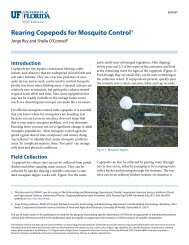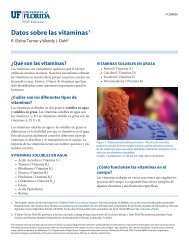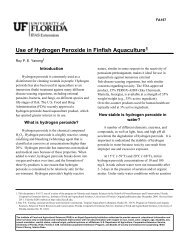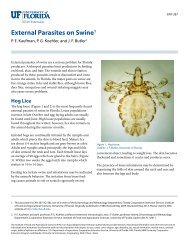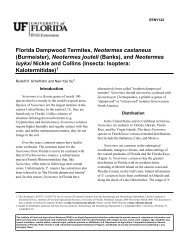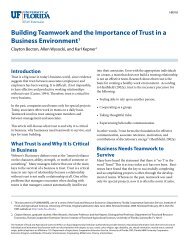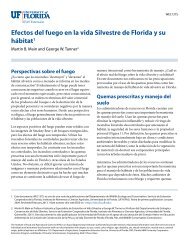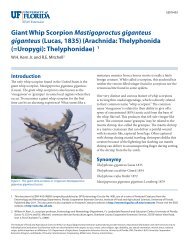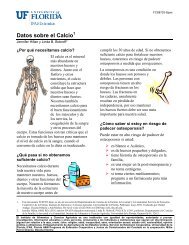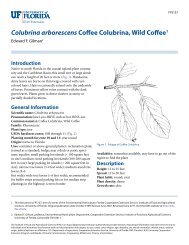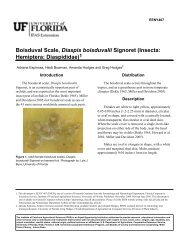Download PDF - EDIS - University of Florida
Download PDF - EDIS - University of Florida
Download PDF - EDIS - University of Florida
Create successful ePaper yourself
Turn your PDF publications into a flip-book with our unique Google optimized e-Paper software.
EENY556<br />
Olive shootworm, Palpita persimilis Munroe (Insecta:<br />
Lepidoptera: Crambidae) 1<br />
James E. Hayden and Lyle J. Buss 2<br />
Introduction<br />
Palpita persimilis Munroe (Lepidoptera: Crambidae) is a defoliator<br />
<strong>of</strong> olives and privet in South America (Gomez 1999;<br />
Chiaradia and Da Croce 2008). Examination <strong>of</strong> specimens<br />
submitted to UF-IFAS and FDACS-DPI prompted the discovery<br />
that the species has been established in <strong>Florida</strong> for<br />
many years, having been confused with two similar native<br />
species. The confusion parallels historical misidentifications<br />
in Peru (Gomez 1999). To date, all vouchered specimens in<br />
<strong>Florida</strong> with host information were found feeding on leaves<br />
<strong>of</strong> Ligustrum japonicum Thunb. (Japanese privet).<br />
Palpita Hübner includes several dozen tropical and temperate<br />
species globally, most <strong>of</strong> which feed on Oleaceae if the<br />
host is known. Palpita vitrealis (Rossi), better known by the<br />
synonym Palpita unionalis (Hübner), is a major pest <strong>of</strong> olive<br />
and jasmine in Europe and Asia (Yilmaz and Genç 2012).<br />
Palpita nigropunctalis (Bremer) in East Asia feeds on several<br />
oleaceous species, including ligustrum and lilac (Gotoh et<br />
al. 2011). The larvae commonly construct untidy webs <strong>of</strong><br />
leaves and silk in which they consume the leaves and, in<br />
some species, also the fruit.<br />
The initial detection in <strong>Florida</strong> was an infestation <strong>of</strong><br />
ornamental privet trees in Sumter County in July 2012.<br />
The homeowner indicated that other infestations were<br />
Figure 1. Palpita persimilis, adult habitus. Scale = 1 cm.<br />
Credits: James E. Hayden<br />
Figure 2. Palpita persimilis, live adult.<br />
Credits: Lyle J. Buss<br />
1. This document is EENY556, one <strong>of</strong> a series <strong>of</strong> the Entomology and Nematology Department, <strong>Florida</strong> Cooperative Extension Service, Institute <strong>of</strong> Food<br />
and Agricultural Sciences, <strong>University</strong> <strong>of</strong> <strong>Florida</strong>. Original publication date May 2013. Visit the <strong>EDIS</strong> website at http://edis.ifas.ufl.edu.<br />
2. James Hayden, <strong>Florida</strong> Department <strong>of</strong> Agriculture and Consumer Services, Division <strong>of</strong> Plant Industry, and affiliate faculty, Department <strong>of</strong> Entomology<br />
and Nematology; and Lyle Buss, senior biological scientist; Department <strong>of</strong> Entomology and Nematology, Cooperative Extension Service, Institute <strong>of</strong><br />
Food and Agricultural Sciences, <strong>University</strong> <strong>of</strong> <strong>Florida</strong>, Gainesville, FL 32611.<br />
The Institute <strong>of</strong> Food and Agricultural Sciences (IFAS) is an Equal Opportunity Institution authorized to provide research, educational information and other services only to<br />
individuals and institutions that function with non-discrimination with respect to race, creed, color, religion, age, disability, sex, sexual orientation, marital status, national<br />
origin, political opinions or affiliations. U.S. Department <strong>of</strong> Agriculture, Cooperative Extension Service, <strong>University</strong> <strong>of</strong> <strong>Florida</strong>, IFAS, <strong>Florida</strong> A&M <strong>University</strong> Cooperative<br />
Extension Program, and Boards <strong>of</strong> County Commissioners Cooperating. Nick T. Place , Dean
Figure 3. Labial palpi and foreleg tibia: A. Palpita persimilis; B. Palpita kimballi; C. Palpita quadristigmalis.<br />
Credits: James E. Hayden<br />
unreported in the area. More specimens were subsequently<br />
found in the <strong>Florida</strong> State Collection <strong>of</strong> Arthropods<br />
(FSCA), the earliest <strong>of</strong> which were raised on privet in<br />
January 1980 at the Fort Lauderdale IFAS Agricultural<br />
Research Center. Vouchered adults from 1992 (Valrico, FL)<br />
and 1999 (St. Cloud, FL) were raised from larvae feeding on<br />
privet in nurseries. Several lots <strong>of</strong> Palpita larvae that may<br />
represent the same species have been collected on privet<br />
since the early 1980s.<br />
Distribution<br />
The distribution includes southern Brazil, Bolivia (Sara<br />
Department), Peru, Costa Rica, northern Venezuela,<br />
Guadeloupe, Saint Kitts, the Dominican Republic, Haiti<br />
and Cuba (Munroe 1959; Alayo and Valdes Arteaga 1974;<br />
Gomez 1999; FSCA and MGCL specimens). <strong>Florida</strong><br />
counties represented by vouchered adult specimens include<br />
Broward, Collier, Hillsborough, Miami-Dade, Monroe,<br />
Osceola and Sumter. The southern and central counties<br />
represent two centers <strong>of</strong> distribution. Geographically,<br />
the nearest population is in Cuba, where it was recorded<br />
on olive and privet (Alayo and Valdes Arteaga 1974). In<br />
addition, many lots <strong>of</strong> larval specimens <strong>of</strong> Palpita sp. were<br />
collected on privet in southeastern <strong>Florida</strong> counties in<br />
the early 1980s. Identification as Palpita persimilis cannot<br />
be confirmed without an adult specimen, but the sudden<br />
increase <strong>of</strong> infestations makes the identity plausible.<br />
Diagnosis<br />
The wingspan <strong>of</strong> observed specimens varies from 19 to 27<br />
mm (Fig. 1). The almost entirely white wings are practically<br />
indistinguishable from those <strong>of</strong> two other Palpita species<br />
in <strong>Florida</strong>, Palpita kimballi Munroe and Palpita quadristigmalis<br />
(Guenée). However, the body size and aspects <strong>of</strong><br />
coloration are useful for distinguishing Palpita persimilis.<br />
The labial palpi (Fig. 3A) are mostly reddish brown with<br />
distinct dark-brown to black scales bordering the reddish<br />
area dorsally and ventrally; the same dark scales are also<br />
prominent on the maxillary palpi and lateral margin <strong>of</strong> the<br />
frons. The foreleg tibia (Fig. 3A) has distinctly black scales<br />
proximally and distally that contrast with the orange-brown<br />
femur. Palpita kimballi is the same size but lacks the black<br />
scales; the palpi are nearly uniformly reddish brown,<br />
with at most a few darker scales, and the foreleg tibia is<br />
orange-brown like the femur (Fig. 3B). Conversely, Palpita<br />
quadristigmalis has similar dark scales on the palpi and<br />
forelegs, although more brown or gray and not quite as<br />
distinct, but the average size is larger (26-30 mm in FSCA<br />
specimens). The forewings also have a slightly yellowish<br />
tinge, although assessment requires direct comparison<br />
<strong>of</strong> the different species under good, consistent lighting.<br />
However, specimens <strong>of</strong> Palpita persimilis from the earliest<br />
interception (Broward Co.) are large and slightly yellow, like<br />
Palpita quadristigmalis, so definite identification requires<br />
genitalic dissection.<br />
Two other species <strong>of</strong> related moths with white wings occur<br />
in the subtropical Nearctic. Palpita flegia (Cramer) is<br />
common in <strong>Florida</strong>, with a much larger wingspan (3.5-5.0<br />
cm) and a blue-gray forewing costa and white palpi. Palpita<br />
flegia is a conspicuous pest <strong>of</strong> yellow oleander (Thevetia<br />
peruviana (Pers.) K. Schum.). Diaphania costata (Fabricius)<br />
occurs in Texas, Oklahoma and the Caribbean, so it could<br />
occur in <strong>Florida</strong> as a rare stray. It averages 30 mm in<br />
wingspan, and it has an orange-brown forewing costa and<br />
orange palpi without black scales. Males have a tuft <strong>of</strong> hairs<br />
in a pocket underneath the forewing costa. Larvae <strong>of</strong> both<br />
species feed on Apocynaceae rather than Oleaceae and<br />
have the male antenna modified at the base with a mesally<br />
swollen scape and pedicel and a sinus onthe flagellum. The<br />
classification <strong>of</strong> both species is provisional, and they may be<br />
Olive shootworm, Palpita persimilis Munroe (Insecta: Lepidoptera: Crambidae)<br />
2
more closely related to Old World genera such as Stemorrhages<br />
Lederer.<br />
Four more species <strong>of</strong> true Palpita are known in <strong>Florida</strong>: the<br />
widespread Palpita magniferalis (Walker), Palpita illibalis<br />
(Hübner), Palpita freemanalis Munroe in the <strong>Florida</strong><br />
Panhandle, and Palpita maritima Sullivan and Solis (Sullivan<br />
and Solis 2013). There is little chance <strong>of</strong> confusing<br />
them, because the wings are mottled brown, gray and<br />
white, and the genitalia have symmetrical valve processes<br />
(Munroe 1952).<br />
Male genitalia: Palpita persimilis has elongate processes on<br />
the valvae that curve around to parallel the distal margin<br />
<strong>of</strong> the valva (Fig. 4). Each process has two parts. The inner<br />
parts are symmetrical and have swollen, grooved apices.<br />
The outer parts are narrow and asymmetrical, with the<br />
right-hand one nearly as long as its inner part and slightly<br />
bifurcate, and the left-hand one half as long as its inner<br />
counterpart. Palpita quadristigmalis and Palpita kimballi<br />
have much shorter, crescent-shaped processes that are<br />
closer to the base <strong>of</strong> the valva and do not come close to<br />
paralleling the distal margin; they are symmetrical in the<br />
former species and asymmetrical in the latter.<br />
Female genitalia: In Palpita persimilis (Fig. 5A), the<br />
lamella postvaginalis is slightly asymmetrical with respect<br />
to a spout-like mediodistal depression. The lamella is flat,<br />
rounded and symmetrical in the other white species in<br />
<strong>Florida</strong> (Fig. 5B, C).<br />
Eggs: Females lay up to 200 eggs singly on the underside<br />
<strong>of</strong> leaves. The eggs are greenish yellow and 0.5 mm in<br />
diameter (Chiaradia and Da Croce 2008).<br />
Larva: Characters used to diagnose larvae <strong>of</strong> Palpita<br />
persimilis from other Palpita species are not yet known.<br />
Live larvae are green with a pale yellow head and grow<br />
Figure 4. Male genitalia. Elongate processes <strong>of</strong> right valve indicated.<br />
Credits: James E. Hayden<br />
to a length <strong>of</strong> about 2 cm (4/5 in.) (Fig. 6). Young larvae<br />
(Fig. 11) are similar to older stages. The prothoracic shield<br />
may be mottled to nearly colorless. The dorsal pinacula<br />
and the ventral margin <strong>of</strong> the subdorsal pinacula may or<br />
may not be pigmented dark brown; most other pinacula<br />
are not pigmented. When the pinacula are not otherwise<br />
colored, a distinct brown spot is obvious on the subdorsal<br />
pinaculum <strong>of</strong> the second thoracic segment (Fig. 7A). This<br />
last character also occurs in other Palpita species that feed<br />
on Oleaceae (Allyson 1984) as well as a few other crambid<br />
moths, such as the Bougainvillea caterpillar (Asciodes<br />
gordialis [Guenée]) and some specimens <strong>of</strong> the Mulberry<br />
leaftier (Glyphodes sibillalis Walker). The spot is obscured<br />
when other pinacula are colored (Fig. 7B).<br />
Figure 5. Female genitalia: A. Palpita persimilis, lamella postvaginalis indicated; B. lamella postvaginalis <strong>of</strong> Palpita kimballi; C. same, Palpita<br />
quadristigmalis.<br />
Credits: James E. Hayden<br />
Olive shootworm, Palpita persimilis Munroe (Insecta: Lepidoptera: Crambidae)<br />
3
horn-shaped signa (sclerites, Fig. 5A); larva on Oleaceae . . .<br />
. . . Palpita spp. 3<br />
3(2’). Forewing length 2.6-3.0 cm (1.0-1.2 in); palpi and<br />
foreleg tibia with brown-gray scales (in <strong>Florida</strong> population;<br />
Fig. 3C); male valva with three short, symmetrical claspers<br />
in crescent shape; lamella postvaginalis circular (Fig. 5C) . .<br />
. . . . . . Palpita quadristigmalis<br />
Figure 6. Live larva, about 2 cm long.<br />
Credits: James E. Hayden<br />
3’. Forewing length 1.9-2.7 cm (0.75-1.1 in); foreleg tibia<br />
orange or black; male valvae with asymmetrical claspers;<br />
female lamella postvaginalis longer than wide . . . . . . 4<br />
4(3’). Palpi and foreleg tibia orange (Fig. 3B); male with<br />
short, crescent-shaped claspers; lamella postvaginalis<br />
symmetrical and not tapered like a spout (Fig. 5B) . . . . .<br />
Palpita kimballi<br />
Figure 7. Detail <strong>of</strong> thoracic subdorsal pinacula: A. brown spot<br />
indicated on subdorsal pinaculum <strong>of</strong> second thoracic segment; B.<br />
pinaculum entirely melanized, obscuring the brown spot.<br />
Credits: James E. Hayden<br />
Pupa: No diagnostic characters are known for the pupa.<br />
Key<br />
The following key applies to adults <strong>of</strong> white-winged Palpita<br />
and related species in <strong>Florida</strong> and nearby areas.<br />
4’. Palps with black edges and foreleg tibia black (Fig. 3A);<br />
male with long claspers reaching near distal end <strong>of</strong> valva<br />
(Fig. 4); lamella postvaginalis asymmetrical, tapered like a<br />
spout (Fig. 5A) . . . . . . Palpita persimilis<br />
Hosts<br />
Ligustrum japonicum Thunb. (Japanese privet) in <strong>Florida</strong><br />
and elsewhere, and Olea europaea L. (olive) in southern<br />
and western South America (Wille 1952; Chiaradia and Da<br />
Croce 2008).<br />
1. Wingspan 3.5-5.0 cm (1.4-2.0 in); forewing costa bluish<br />
gray; base <strong>of</strong> male antennal flagellum with hollow sinus;<br />
larva on Apocynaceae . . . . . . . . Palpita flegia<br />
1’. Wingspan 3.0 cm (1.2 in) or less; forewing costa orangebrown;<br />
base <strong>of</strong> male antenna usually not modified; larva<br />
usually on Oleaceae, rarely Apocynaceae . . . . . . . 2<br />
2(1’). Wing without spots, or with at most one spot on<br />
discal cell; male with base <strong>of</strong> antennal flagellum hollowed<br />
and scale-covered; tuft <strong>of</strong> hair in ventral pocket along male<br />
forewing costa; male valva with one small downturned<br />
clasper; female with ostium bursae unmodified and corpus<br />
bursae without signa (sclerites); larva on Apocynaceae . . . .<br />
. . Diaphania costata (possible stray from Caribbean)<br />
Figure 8. Feeding damage to epidermis <strong>of</strong> leaf.<br />
Credits: James E. Hayden<br />
2’. Forewing with one small black spot on central cell, two<br />
or three spots along costa, and two or three at margin <strong>of</strong><br />
wing apex (Fig. 1-2); male antenna and base <strong>of</strong> wing never<br />
modified or tufted; male valva with two or three upturned<br />
claspers (Fig. 4); female with ostial plate (lamella postvaginalis,<br />
Fig. 5A-C), and corpus bursae with pair <strong>of</strong> large,<br />
Olive shootworm, Palpita persimilis Munroe (Insecta: Lepidoptera: Crambidae)<br />
4
(Fig. 9). Damage can result in the curling <strong>of</strong> older leaves.<br />
In the primary observation in Sumter County, foliage was<br />
trimmed at the end <strong>of</strong> July to remove nests and eggs, but<br />
within five weeks, new flushes <strong>of</strong> leaves were supporting<br />
another large population (Fig. 10).<br />
Figure 9. Leaves tied together with larva inside.<br />
Credits: James E. Hayden<br />
Behavior<br />
Wille (1952) and Chiaradia and Da Croce (2008) describe<br />
larval behavior in South America. The number <strong>of</strong> days until<br />
egg hatch depends on temperature, ranging from 8 to 15<br />
days. Early instar larvae consume buds and tender leaves,<br />
and later instars may eat older, harder leaves. They roll<br />
leaves into nests, stripping the surface or skeletonizing, and<br />
the buds and leaves dry up. They eat the olive fruits only<br />
rarely, and damage to flowers is not reported. The larval<br />
stage lasts 30 to 45 days. Pupation usually occurs in crevices<br />
in the bark and lasts 10 to 20 days. Total generation time is<br />
50 days in spring to 65-80 days in winter. There may be five<br />
or six generations per year. Adults are active by day as well<br />
as night, but they are reclusive and hide under leaves <strong>of</strong> the<br />
host. Elevated temperatures (especially warm winters) and<br />
high precipitation and humidity favor population growth<br />
(Wille 1952; Chiaradia and Da Croce 2008). Observations<br />
<strong>of</strong> the species in <strong>Florida</strong> agree with the above. Larvae <strong>of</strong><br />
all stages prefer young leaves and new growth, but not<br />
flowers. They feed primarily on the epidermis (Fig. 8), but<br />
older larvae can eat holes in larger leaves. They construct<br />
shapeless, frass-laden nests <strong>of</strong> leaves tied together with silk<br />
Figure 10. Defoliation <strong>of</strong> new growth.<br />
Credits: Lyle J. Buss<br />
Management<br />
Control measures are difficult because <strong>of</strong> the habit <strong>of</strong><br />
concealed feeding. Several natural enemies have been tested<br />
with varying success (Chiaradia and Da Croce 2008). Trimming<br />
foliage to remove eggs and nests, if applied, should be<br />
done thoroughly, because any surviving larvae will prefer to<br />
consume the resulting new growth.<br />
Figure 11. Young larva, about 2 mm long.<br />
Credits: Lyle J. Buss<br />
Acknowledgements<br />
We thank Dr. M. A. Solis (USDA-ARS) for confirming the<br />
identification and L. A. Chiaradia (Epagri/Cepaf, Santa<br />
Catarina, Brazil) for providing a copy <strong>of</strong> his important<br />
publication. Dr. J. B. Heppner (McGuire Center for<br />
Lepidoptera, Gainesville, FL) vouchered specimens in the<br />
FSCA. Dr. C. V. Covell, Jr. (McGuire Center), L. Somma, C.<br />
Whitehill, and Dr. W. Dixon (FDACS-DPI) provided many<br />
helpful comments and suggestions for the manuscript.<br />
Selected References<br />
• Alayo DP, Valdes Arteaga V. 1974 [1975]. Notas sobre<br />
Lepidópteros de Cuba. I. Poeyana 139: 1-11.<br />
• Allyson S. 1984. Description <strong>of</strong> last-instar larvae <strong>of</strong> 22<br />
species <strong>of</strong> North American Spilomelini (Lepidoptera:<br />
Pyralidae: Pyraustinae) with a key to species. The Canadian<br />
Entomologist 116: 1301-1334.<br />
• Chiaradia LA, Da Croce DM. 2008. Caracterização, danos<br />
e manejo de pragas da oliveira. Agropecuaria Catarinense<br />
21:53-55.<br />
Olive shootworm, Palpita persimilis Munroe (Insecta: Lepidoptera: Crambidae)<br />
5
• Gomez H. 1999. La verdadera identidad del “gusano<br />
del brote del olivo” en el Perú (Lepidoptera, Pyralidae).<br />
Revista Peruana de Entomologia 41: 19-22.<br />
• Gotoh T, Hagino Y, Doke K. 2011. Life cycle <strong>of</strong> the lilac<br />
pyralid Palpita nigropunctalis (Bremer) (Lepidoptera:<br />
Crambidae) on five oleaceous tree species. Journal <strong>of</strong><br />
Asia-Pacific Entomology 14: 195-200.<br />
• Munroe EG. 1952. The illibalis group <strong>of</strong> the genus<br />
Palpita Hübner (Lepidoptera: Pyralidae). The Canadian<br />
Entomologist 84: 43-55.<br />
• Munroe, EG. 1959. New species and a new subspecies<br />
<strong>of</strong> Palpita (Lepidoptera: Pyralidae). The Canadian Entomologist<br />
91: 641-650.<br />
• Sullivan, J.B. and M.A. Solis. 2013. A new species <strong>of</strong><br />
Palpita (Crambidae, Spilomelinae) from the coastal plains<br />
<strong>of</strong> southeastern United States. ZooKeys 264:3-9.<br />
• Wille JE. 1952. Entomología Agrícola del Perú (Ed. 2).<br />
Ministerio del Agricultura, Lima.<br />
• Yilmaz Ç, Gençh. 2012. Determination <strong>of</strong> the life cycle <strong>of</strong><br />
the Olive Fruit Leaf Moth, Palpita unionalis (Lepidoptera:<br />
Pyralidae) in the laboratory. <strong>Florida</strong> Entomologist 95:<br />
162-170.<br />
Olive shootworm, Palpita persimilis Munroe (Insecta: Lepidoptera: Crambidae)<br />
6



